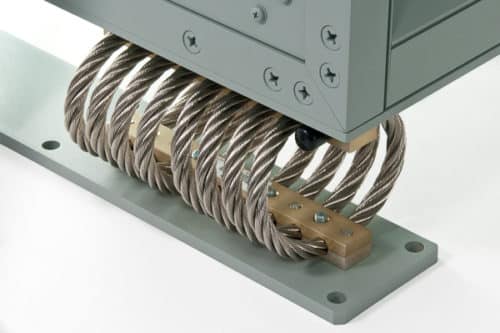Protecting Electronic Devices from Vibration & Shock
1 CommentVibration is bad for electronics. It can damage the boards and components potentially causing permanent failure. But a well-engineered enclosure protects delicate equipment from vibration damage by isolating it from external sources. Utilizing a stabilizer kit for your rack can add an additional layer of security.
These vital electronics are subjected to stressors in a wide spectrum of applications ranging from in-office or industrial power stations to ruggedized, aerospace systems or other military deployment. Even if intended for more mild environments, nearly all electronics are subject to some level of vibration during their lifecycle. Typical shock values for industrial use might be in the 5G to 10G range whereas systems on naval ships need to withstand shocks in excess of 20G.
Looking for Electronic Enclosures?
Types of shock and vibration
If your equipment is mounted on a ground-based or airborne vehicle, shipboard mounted or needs to withstand natural weather patterns and seismic events, ruggedized construction should be one of the, if not THE, primary design criteria.
There are two types of vibration: random or sinusoidal. Random is a varying waveform similar to riding in a vehicle rolling across rough terrain. Sinusoidal vibration occurs at distinct frequencies and is continuous, like that of a rotating engine on a helicopter.
Stress testing can uncover defects in a design before they become expensive problems. And often times, the only way to verify that a rack and its isolation mounts will provide sufficient protection is through instrumented testing. Our A&J electronic equipment racks have been designed and tested to meet MIL standards:
- MIL-STD 810F — environmental shock and vibration
- MIL-STD-167 — shipboard vibration
- MIL-STD-901D — high impact and shock testing for Navy shipboard machinery and equipment
Rugged Design that Meets MIL-STD
Rack Type | Test | Rack Height (in) | Model | Test Results |
Light Duty | Shock | 72 | 9264-1000-1 | MIL-S-901C |
Light Duty | Shock and Vibration | 72 | 9096-109 | MIL-S-901C Blows |
Medium Duty | Shock and Vibration | 76 | 9260-1000 | MIL-STD-810, method 516 |
Medium Duty | Shock | 72 H, 30 D | 9399-1000 | MIL-S-901C |
Medium Duty | Shock | 60 | 60-D1-1001 | MIL-S-901C 9 |
Medium Duty | Shock and Vibration | 68.68 | 9216-1000 | MIL-S-901C 9 Blows |
Medium Duty | Shock and Vibration | 72 | 9194-100 | MIL-S-901C 12 Blows |
Medium Duty | Shock and Vibration | 59 | 9153-1000 | MIL-S-901C 9 Blows |
Medium Duty | Shock and vibration | 72 | 72-D1-1001 | MIL-S-901C 9 Blows |
Medium Duty | Shock and vibration | 40 | 9149-100 | MIL-S-901C 6 Blows |
Medium Duty | Shock and vibration | 72 H, 36 D, 36 W | 9423-1001 | MIL-S-901C 9 Blows |
Medium Duty | Shock | 60 | 60-D1-1001 | MIL-S-901C 9 Blows |
Heavy Duty | Shock and Vibration | 76 | 76-G1-1001 | MIL-S-901C Blows |
Heavy Duty | Shock and vibration | 72 | 9143-100 TG-2 | MIL-S-901C 9 Blows |
Key rack components to protect against shock & vibration
Isolators
The main goal in handling shock and vibration is to isolate the equipment from excitement by reducing the amplitude and frequency of waves. Enter: isolators. They’re critical! And act as a highly stable buffer between the source of the vibration and the object or surface. A good system has two main components, a spring to support the load and a damping element to dissipate the energy.

- Wire Rope Coils – the ideal solution for providing low frequency, highly damped vibration isolation and excellent shock attenuation. They often require little maintenance, are made from durable metals and keep functioning under varying temperatures in corrosive environments.
- Seismic Mounts – whether you’re in a seismic region of the country or on a Naval ship, these mounts are designed to provide the strength and isolation necessary to control the motion of equipment
Varying the size, shape, construction material and number of coils all affect the spring rate and damping, as well as mounting placement.
Common applications for vibration and shock isolators include avionics and equipment, computer equipment and disc drivers, control panels, electrical transformers, fans and blowers, industrial machinery, marine and shipboard equipment, medical equipment, power plants and cooling towers, pumps and centrifuges, and compressors.
Rack Frame
Obviously, the rack’s exterior frame should be rigid construction to withstand any buckling. At A&J, we developed a unique bolted-together design that lends structural integrity, eliminating the need for welding. The modular design allows a wide range of sizes and configurations to be incorporated. For seismic zones or rugged applications, a back stiffener or X-brace can be added near the top, middle and bottom to protect from movement. Another option to consider is double-walled construction where the frame has two layers of sheet metal for extra strength.
Contact us for more detail on a particular enclosure design feature or schedule a chat with one of our engineers.
Read More: Thinking About a Custom Rack Design? Here’s What to Consider

